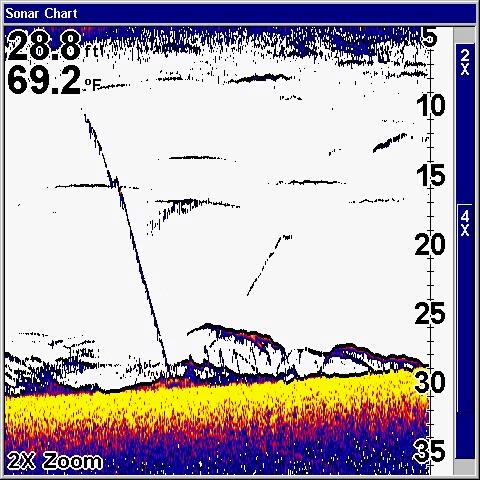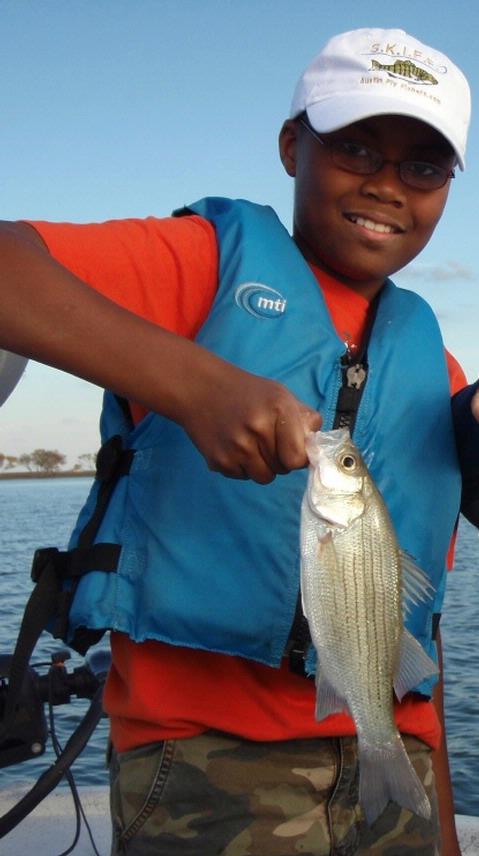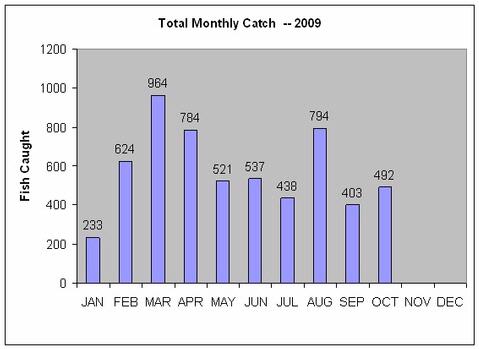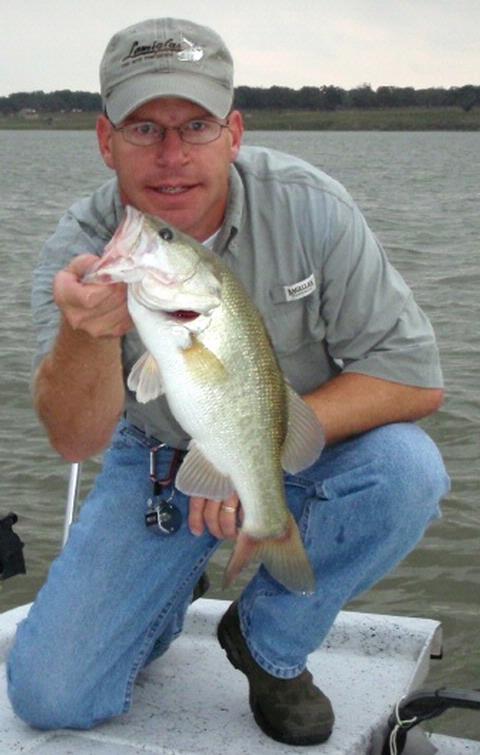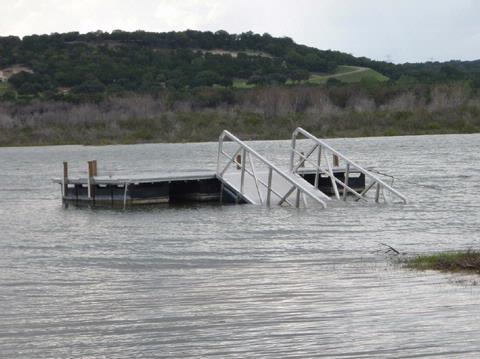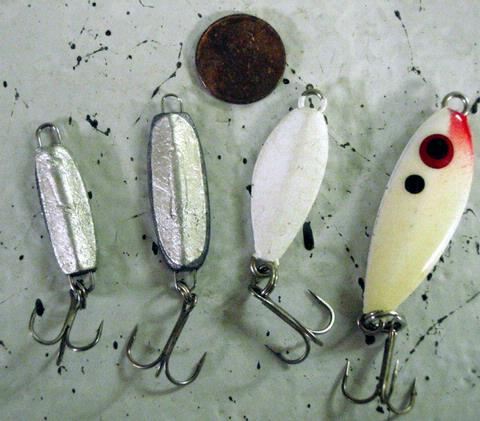Today’s trip really underscored the impact winds have on fishing. This morning was the first time in a long time we had a wind I could get excited about — slowly increasing in speed throughout the morning and from just south of southwest. This set of conditions virtually guarantees a great day of fishing when it occurs, and our results today proved that out. Of 93 fish taken, 84 of them came in the morning when the winds were SSW. After noon, as the wind got stronger and came out of the east, the bite died down, only giving up 9 in the last 4 hours of the day.
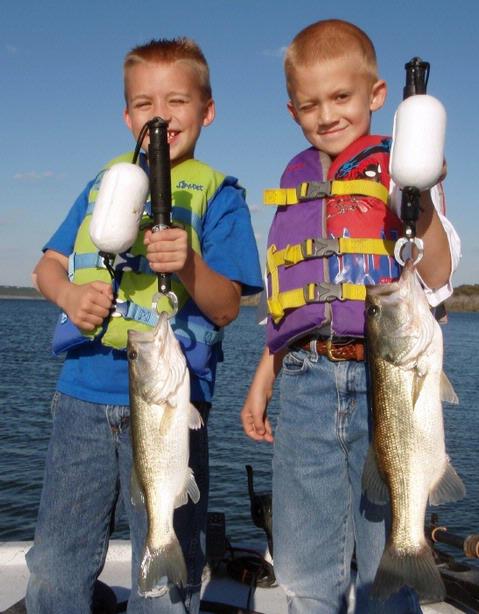
Jacob (L) and Zachary (R) with a pair of crankbait bass taken this windy October 19th afternoon.
Start Time:7:30a
End Time: 7:20p
Air Temp: 75F at trip’s start.
Water Surface Temp: ~73.1F
Wind: Winds were from the SSW in the morning starting at 7 and slowly ramping up to 18 by 11:30. Around 1pm the wind turned SSE and ramped up to about 22mph, tapering off to 14mph by trip’s end.
Skies: Skies were fair, cloudless and bright.
I headed out this morning and did a little exploring given the current water temperatures, shorter days, and early transition to fall weather.
Before sunrise I fancast a blade around Area 999 probing for some shallow white bass. I got 3 strikes, but no hookups in about 50 casts, and all of these strikes were on the fall, indicating sluggish fish — which isn’t uncommon given the low light conditions at this point. Regardless, this didn’t scream out to me to linger here, so I continued the search.
I first searched over the expanse of water from Area 114 to Area 112 and found schools of small white bass surface feeding on late-spawn shad fry on the surface. You really had to suspect these fish were there to start with, as they were feeding on these small prey fish so lightly and the wind was rippling the water such that there was essentially no visual cue that these fish were there — no sound, no splashes, no spray thrown in the air — nothing but a little “nervous water”. I put 7 fish in the boat, all on a Cork Rig, and then moved on looking for other congregations of fish.
I checked out Areas 293 and 317 and found nothing.
I headed to Area 531 and just grinned ear to ear when I saw 3 ospreys all working over a tight little patch of water, and each of them making dives or partial dives several time per minute. This indicates active fish chasing bait at or near the surface. In this case, it turned out to be schools of small white bass chasing small shad to the surface, and it was the small whites that the ospreys were feeding on. I limited my sonar searching and boat noise by slipping into this action from downwind and cutting everything off once I saw the first solid fish returns on sonar. This was a classic vertical jigging scenario with fish responding to jigging, easing, and smoking presentations, and actively pursuing the 1/8 and 1/4 oz. Rattle Snakie slabs, as well as the 3/8 TNT 180. The 1/2 oz. TNT 180 was too much size for them and my catch suffered when I put that one on. I also experimented with white and silver, and white got the nod as the water is still a bit stained from all the wind and water of late. Once the color was nailed down, and the fish showed a willingness to go for up to a 3/8 oz. profile, I kept the TNT 180 on in 3/8 oz. white as I like to use as heavy a slab as the fish are willing to tolerate.
I an area less than 80 foot by 80 foot, I took 77 fish in about 2 1/2 hours’ time. This catch included 4 largemouth (all keepers up to 3 pounds), 2 drum, and 71 white bass. Of these white bass, ~20 went better than 12 inches, with none exceeding 13 inches. The remainder of the white bass were fairly small, but in good condition, going right at 9-10 inches. By around 11:15a the action began to soften so I headed back in to prepare for the evening trip, hoping the wind would keep up with a westerly component.
As 3:00pm approached, I picked up two local 3rd Grade young men for what would be our 11th SKIFF trip of the season. SKIFF (Soldiers’ Kids Involved in Fishing Fun) Trips are provided at no charge to those military children with a parent deployed in harm’s way or who has passed away while on active duty. Here is the report I furnished to the Austin Fly Fishers, the people who raise the funds to make these SKIFF trips possible:
SKIFF TRIP #11
Today’s SKIFF trip was spent in the company of two young men, Zachary Leonard and Jacob Bretthorst. Both are 3rd Graders, both have two younger sisters, and both are very much looking forward to getting their dads back from Iraq. Zachary is the son of Private First Class Daniel Leonard who serves as a medic with the 1st Cavalry Division in Taji, Iraq; and Jacob is the son of Major John Bretthorst who serves as a transportation officer with the 180th Transportation Battalion out of Camp Arifjan.
In order to give the moms of these boys a break, I picked both boys up at their homes. On our way to the boat ramp, I was treated to a recitation of Hebrews, Chapter 11 by Zach who is home-schooled — what a nice touch that was!
As we drove toward Stillhouse Hollow Lake, I asked the boys about their familiarity with the different kinds of rods and reels I had on board, and tried to assess their experience level so I knew where to start once we got on the water. I also covered all the items in my safety briefing with the boys while we were on the road.
I kept a sharp eye on the sway of the trees as we neared the lake. The weatherman forecast winds at up to 18mph. It was blowing every bit of 22mph with gusts higher. I was concerned that the wind would greatly limit our options, and that concern turned out to be well-founded.
After getting launched, we headed to a protected area and I taught both boys to cast a spinning outfit. They both got the hang of that in about 6-7 casts each.
We then filled the livewell so we could revive our catch before taking photos, and headed out in pursuit of our quarry. We first searched Area 110 with Reefrunner Ripshads (200 and 400 series) in Mooneye Minnow color. In about an hour’s time the boys boated 3 largemouth bass, of which 2 were keepers and the largest fish of our trip. The boys did real well at playing and landing the fish into a waiting net. We placed the two legal fish in the livewell to revive and for photos. Once we had strained that area thoroughly, I suggested we give a different technique a try in a different area. The boys were up for that.
We headed to north of Area 329 and I quickly saw on sonar that there was both white bass and shad holding here between the face of the slope and the river channel, over the short flat that runs from the channel to the base of the slope. We put Pet Spoons down in 32-35 feet of water, just slightly staggered. We spent about 75 minutes combing over a fair sized piece of bottom, and managed 5 white bass. The first 3 were small, so, when the last two were caught, and they were larger, the boys decided they’d like to cash in their chips and take pictures of both largemouth and both white bass right then and there. The wind was blowing so hard that I knew a good photo was going to be difficult, so we beached for stability’s sake and snapped a few photos to send to their dads.
I once again offered a change of pace, this time to vertical jigging in some 20’+ water near Area 531 for what I thought might be a mixed bag of fish. We embarked on this effort at around 6pm, and found the fishing very tough from this point on. We managed but one more white bass on a 3/8 oz. TNT slab from a very inactive schools of small whites that were hugging bottom tightly. The boys never did land a fish via this technique, but enjoyed learning the technique nonetheless.
With dark approaching around 7:15p, we did a quick visit up into some wind-blown shallows to check on the possibility of white bass at Area 110 to 116. Th
e boys then got to cast blade baits a bit, but we didn’t find fish there.
Our final effort was made by flatline trolling crankbaits along the circuit from Area 114, through Areas 336 and 319, to Area 343. This lent itself to allowing the boys to take the wheel and get an appreciation for steering the boat and navigating by GPS. I was here that our comedian, Zach, posed the question: “What do you get when you cross a chicken and a caterpillar?” To his delight, I gave up. He announced the answer was “Drumsticks for everyone!” I had to chuckle.
At dark we wrapped up our big, wind-blown, adventure. The boys were grinning ear to ear and couldn’t wait to tell their moms all the details of the 9 fish they brought in today. We enjoyed some reminiscing on our drive back to their homes, and I bid farewell to both with a firm handshake.
TALLY: 93 fish, all caught and released
